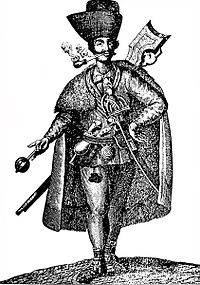- Demographic history of Syrmia
-
This is demographic history of Syrmia.
Contents
Prehistory
Between 3000 BC and 2400 BC, Syrmia was a core area of Indo-European Vučedol culture. [1] [2]
6th-7th century
In 6th-7th century, entire Syrmia region was populated by Slavs. [3] According to other source, it was also populated by Gepids,[4] and Avars. [4]
11th-12th century
In 11th-12th century, according to Hungarian sources, region of Syrmia had partially Slavic and partially mixed Slavic-Hungarian population. [5] Around 1154, Al-Idrisi, a Muslim geographer, described Manđelos as a rich town, whose inhabitants pursued a rather "nomadic way of life". By some opinions, Idrisi might have referred simply to stock-breeding that played an important role among the Hungarian inhabitants of the entire region of Syrmia[6] This fact was confirmed later by several Byzantine authors in the twelve century (Ioannes Kinnamos, Niketas Choniates, Patriarch Michael).[6]
1437
In 1437, the largest part of Syrmia was populated by Serbs.[7] According to other sources Hungarians and Serbs lived mixed in this area in 1437.[6]
1857
According to the census from 1857, 59.4% of population of the part of Syrmia under civil administration and 63.2% of population of the part of Syrmia under military administration (Petrovaradin regiment) were ethnic Serbs. The second largest ethnic group were Croats, while other ethnic groups were Germans, Hungarians, etc.[8]
1910
According to the census from 1910, the population of the Syrmia region (Syrmia county) numbered 414,234 inhabitants, including:[9]
- 183,109 (44.20%) people who spoke Serbian language
- 106,198 (25.64%) people who spoke Croatian language
- 68,086 (16.44%) people who spoke German language
- 29,522 (7.13%) people who spoke Hungarian language
- 13,841 (3.34%) people who spoke Slovak language
- 4,642 (1.12%) people who spoke Rusyn language
- others.
1931
In 1931, the population of Syrmia included:[10]
- 210,000 Serbs
- 117,000 Croats
- 68,300 Germans
- 21,300 Hungarians
- 15,300 Slovaks
- 5,300 Ukrainians
1971
In 1971, the population of the Serbian part of Syrmia (excluding area that belong to Belgrade) numbered 313,926 inhabitants, including:[11]
- Serbs = 228,609 (72.84%)
- Croats = 38,389 (12.23%)
- Slovaks = 14,056 (4.48%)
- Hungarians = 9,376 (2.99%)
- Yugoslavs = 9,086 (2.89%)
- Rusyns = 3,403 (1.08%)
- Ukrainians = 1,512 (0.48%)
- Montenegrins = 1,400 (0.44%)
- Slovenes = 1,065 (0.34%)
- Macedonians = 1,023 (0.33%)
- others.
2001/2002
According to the 2002 census in Serbia, the population of the Serbian part of Syrmia (in geographical borders) numbering 790,697 people and is composed of:[12]
According to the 2001 census in Croatia, the population of the Croatian Vukovar-Srijem county, numbering 204,768, is composed of:[13]
- 160,277 Croats (78.27%)
- 31,644 Serbs (15.45%)
- 2,047 Hungarians (1%)
- 1,796 Rusyns (0.88%)
- 1,338 Slovaks (0.65%)
References
- ^ http://www.vjesnik.hr/html/2001/04/01/Clanak.asp?r=kul&c=1
- ^ http://files.myopera.com/edwardpiercy/blog/Area-Culture-Map-1.JPG
- ^ http://www.camo.ch/illiricum7.htm
- ^ a b Osman Karatay, In search of the lost tribe: the origins and making of the Croatian nation, Ayse Demiral, 2003, p. 46
- ^ http://img704.imageshack.us/img704/8098/11thcent.jpg
- ^ a b c Derek Keene, Balázs Nagy, Katalin Szende, Segregation, integration, assimilation: religious and ethnic groups in the medieval towns of Central and Eastern Europe, Ashgate Publishing, Ltd., 2009, p. 75-76.[1]
- ^ Dr. Aleksa Ivić, Istorija Srba u Vojvodini, Novi Sad, 1929.
- ^ Vasilije Đ. Krestić, Iz prošlosti Srema, Bačke i Banata, Beograd, 2003.
- ^ Szerém (Srijem) County
- ^ Jovan Pejin, Kolonizacija Hrvata na srpskoj zemlji u Sremu, Slavoniji i Baranji, Sremska Mitrovica, 1992.
- ^ Dr. Branislav Bukurov, Bačka, Banat i Srem, Novi Sad, 1978.
- ^ Popis stanovništva, domaćinstava i stanova 2002. Knjiga 1: Nacionalna ili etnička pripadnost po naseljima. Srbija, Republički zavod za statistiku Beograd 2003. ISBN 86-84443-00-09
- ^ http://www.dzs.hr/Hrv/Popis%202001/popis20001.htm
Categories:- History of Syrmia
- History of Vojvodina
- History of Serbia
- History of Croatia
Wikimedia Foundation. 2010.

